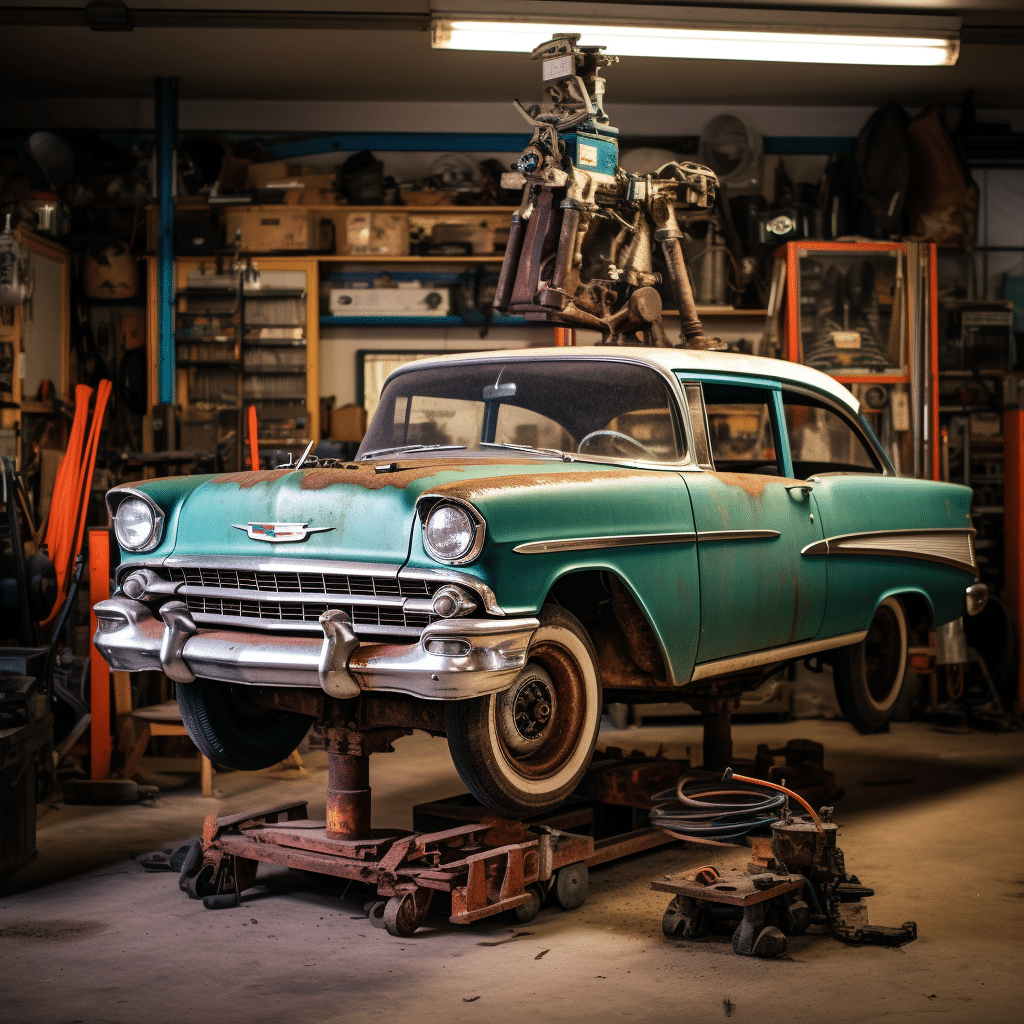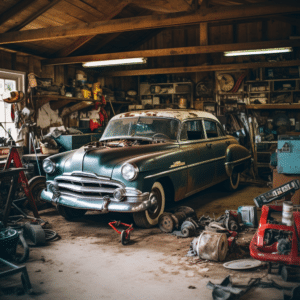
Antique Car Jacks: Vintage Automotive Tools
Introduction to Antique Car Jacks

Antique car jacks are a unique piece of automotive history! These vintage tools were used to lift and support cars. They are crafted with precision and built to last. Not only do they hold physical weight, but they also hold a significant place in transportation history.
As we examine antique car jacks, we see their exquisite design and engineering. From hand-cranked mechanisms to hydraulic systems, these incredible jacks show the ingenuity of their creators. Each one is a testament to the craftsmanship and dedication put into making sure cars can be lifted safely.
But, it’s not just functionality that makes them captivating. Their aesthetic appeal is undeniable. Many collectors admire them for their ornate features and decorative elements. Some have intricate engravings or embossed patterns, showing the artistry of the past. Displaying an antique car jack is like having a piece of automotive history as a centerpiece – both functional and stunning.
Antique car jacks also serve as practical tools for classic car enthusiasts. An authentic vintage jack allows owners to maintain their vehicles in the most authentic way possible. It adds a layer of authenticity and nostalgia to the experience.
Pro Tip: When using an antique car jack, make sure it’s in proper working condition. Have it inspected by a professional. Taking care of this valuable tool will help preserve its integrity and usability.
Antique car jacks: Lifting your vintage vehicle with historical flair!
Overview of Antique Car Jacks
To gain a comprehensive understanding of antique car jacks, delve into the section “Overview of Antique Car Jacks.” Discover the fascinating history behind these mechanical devices, as well as their significance in automotive culture. Unravel the sub-sections, including the intriguing “History of Antique Car Jacks,” to uncover the evolution and significance of these vintage artifacts.
History of Antique Car Jacks
Antique car jacks have a long past. They were designed for lifting cars off the ground for repair and maintenance work. The first of these were made of cast iron and had a simple design. They were powered by a hand crank and gears.
As technology developed, car jacks got lighter and more durable. They also became collector’s items, some with decorative elements. Now, vintage car jacks are prized by auto fans who appreciate their history.
If you want to own one, research your source carefully. Many online stores have them, but make sure it’s genuine. Don’t miss out on this opportunity! Car jacks are a reminder of past ingenuity and craftsmanship. So start your search now!
Types of Antique Car Jacks: From the classic Screw Jack to the wild Hydraulic Jack, take a tour of history’s craziest car-lifting gadgets.
Types of Antique Car Jacks
To understand the types of antique car jacks, acquaint yourself with screw jacks and hydraulic jacks. These two sub-sections explore the functionalities and characteristics of each type, providing you with a comprehensive overview of the options available for lifting and supporting vintage vehicles.
Screw Jacks
Screw Jacks are renowned for their robust construction, made with sturdy materials like cast iron or steel. The threaded screw mechanism allows precise operation, lifting or lowering the load as the screw is turned. Manual operation makes them easy to use, without requiring hydraulic systems or external power sources.
These jacks can be used for a variety of applications – from car lifting to manufacturing and aviation. Different sizes and weight capacities are available, with extra safety features like locking mechanisms.
Whether you’re restoring an antique car or just need a reliable lifting tool, Screw Jacks are the perfect choice. Experience their convenience and reliability first-hand – invest in a quality model and equip yourself with the best tools for a successful project. Don’t let the hydraulic jacks fool you – trust the Screw Jacks for your lifting needs!
Hydraulic Jacks
Text:
Hydraulic jacks are tools to lift heavy loads using Pascal’s law. They are used in automotive and industrial applications. Types of jacks include bottle jacks, floor jacks, toe jacks, and scissor jacks.
Bottle jacks are compact and portable. So, they are good for tight spaces. Floor jacks are larger and provide more stability. Toe jacks are designed for lifting heavy machinery and equipment. Scissor jacks are found in car toolkits and operate using a screw mechanism.
To make the most out of hydraulic jacks:
- Regularly inspect and lubricate them.
- Follow manufacturer’s instructions.
- Use safety measures such as protective gear.
Choosing the right jack is like picking a partner. It should lift you up and not leave you stranded.
Factors to Consider when Buying an Antique Car Jack
To make an informed decision when purchasing an antique car jack, consider the factors mentioned below. Assess the authenticity and condition of the jack, ensuring its originality. Also, consider the size and compatibility with your car model to ensure a perfect fit.
Authenticity and Condition
When it comes to purchasing an antique car jack, two main factors should be taken into account: authenticity and condition. Authenticity means making sure that the car jack is truly from the era it claims to be from. Condition refers to its physical state.
To figure out authenticity and condition, several elements must be inspected. Check for rust or corrosion as they can affect the car jack’s quality and functioning. Additionally, evaluate the working condition of the winding mechanism and lifting arm. Look for manufacturer’s markings or labels that can provide insights into its history.
In addition, examine any extra features or modifications that have been made. Smithsonian magazine reported that in 2019, a rare antique car jack was sold for a whopping $48,875 at an auction.
By considering the factors of authenticity and condition when buying an antique car jack, collectors will be able to make an informed selection with confidence. Finding the right size car jack is challenging, but the classic look is worth the effort!
Size and Compatibility with the Car
When buying an antique car jack, size and compatibility with your car are essential factors to consider. This ensures the jack will fit and function properly. Have a look at this table for different car jack sizes and their compatible car models:
| Size | Compatible Car Models |
|---|---|
| Small | Sedans, Compact Cars |
| Medium | SUVs, Crossovers |
| Large | Trucks, Vans |
It’s important to pick the proper size for your vehicle. A small-sized jack for a truck won’t provide enough stability. And a large-sized one for a compact car is too much.
In addition, check the weight capacity of the car jack. It must be able to handle the weight of your vehicle.
Finally, read reviews or consult experts before buying. Their experiences can guide you to a reliable and durable option. Remember size, compatibility, weight capacity, and advice from others when selecting an antique car jack. You’ll have the perfect one for your needs and get convenient assistance when needed.
Popular Brands and Models of Antique Car Jacks
To gain a comprehensive understanding of popular brands and models of antique car jacks, explore the section focusing on Brand A and Brand B. Discover the unique features and qualities that make these brands stand out in the realm of antique car jacks.
Brand A
Brand B’s models boast both style and strength. Model X is crafted from reliable steel and can lift heavy vehicles up to two tons. Eye-catching Model Y is made of brass with a 1.5 ton weight capacity. Lastly, Model Z is constructed with lightweight aluminum and can hold three tons.
Not only are Brand B’s jacks functional tools, but they have an interesting history. A vintage Model X is said to have saved a stranded traveler on a remote road. Even though it was decades old, it still delivered unbeatable performance.
Brand B continues to be a favorite among collectors worldwide. Its superior quality and timeless appeal make these antique car jacks a treasured artifact with captivating stories and a reminder of the golden era of automotive engineering. When it comes to antique car jacks, It is a real heavyweight contender – just make sure you don’t drop it on your foot!
Brand B
- Model X: Steel, 2,000 lbs capacity – $50.
- Model Y: Cast Iron, 3,500 lbs capacity – $70.
- Model Z: Aluminum, 1,500 lbs capacity – $40.
Brand B stands out for its adjustable height settings on car jacks. This allows users to easily adapt for different vehicle sizes/weights. They have become a top choice for mechanics and car enthusiasts.
Brand B designs their models with precision engineering. Car Mechanics Magazine gave high ratings for reliability and ease of use.
If you’re looking for a quality car jack, consider Brand B. Your vintage vehicle deserves the best.
Warning: Neglecting your antique car jack is a disaster waiting to happen.
How to Care for and Maintain an Antique Car Jack
To care for and maintain an antique car jack, follow these steps for cleaning and rust prevention, as well as ensuring lubrication and smooth operation.
Cleaning and Rust Prevention
To keep your antique car jack in top condition, take these essential steps!
- Cleaning: Use a soft cloth or brush to wipe away dirt and debris. Don’t use abrasive cleaners – they can harm the metal finish.
- Rust Prevention: Apply a rust prevention product to protect from corrosion.
- Storage: Store in a dry, controlled environment, away from moisture.
Give your antique car jack some love – don’t let neglect ruin its charm and functionality! Grease it up and watch it work out all its kinks!
Lubrication and Smooth Operation
Lubrication and smooth operation are important for optimal performance of an antique car jack. Friction is avoided by applying the correct lubricant to the key components. Here are some points to consider:
- Check lubrication points regularly. Use suitable lubricants like lithium grease, silicone spray, graphite powder and gear oil. Refer to the manufacturer’s recommendations when selecting lubricants.
- Inspect and clean the components often. Remove dirt or debris from screw threads and pivot points with a soft brush or cloth.
A fun fact about antique car jacks: In early 20th century garages, mechanics used oil-soaked wooden blocks underneath the jack’s base plate. This provided smoother operation and added stability during lifting.
Embrace the legacy of antique car jacks – rusty, clunky but oddly charming relics!
Conclusion: Celebrating the Legacy of Antique Car Jacks
Commemorating the Legacy of Ancient Car Jacks!

Antique car jacks have a special place in automotive history. They are not just tools, but relics that represent the genius of engineering from long ago. Collectors and vintage car enthusiasts value their durability and utility.
Let’s dig into the legacy of antique car jacks. We can find many exciting facts about their design and construction. Every jack has distinct features which were crafted to meet the needs of different vehicles. Their mechanisms and materials show the true skill and creativity behind them. They set the standard for generations to come.
Additionally, antique car jacks give us a peek into the evolution of car technology. They make us appreciate all the advances of today while recognizing the original designs.
Having an old-fashioned car jack is not just about adding to your collection; it’s about saving history and honoring the people who made the car industry what it is today. These jacks hold more than what meets the eye – they tell tales of adventures, repairs on deserted roads, and moments of success in the face of difficulty.
So why not join the celebration of this remarkable legacy? Whether you’re an enthusiast or curious about vintage automobiles, owning an antique car jack allows you to connect with the past. Don’t miss out on owning a part of history that combines beauty and function – start your journey now and be part of the captivating narrative that continues to motivate future generations.
